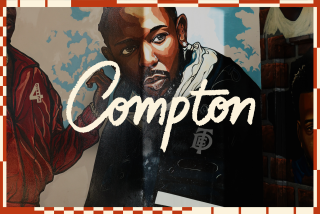Battle for a Bobâs Big Boy : Newport Man Hopes to Raze Place; Others Fight for It
Philip MacDonald has a lifelong history with the Bobâs Big Boy in Burbank.
His dad built the neon-lit coffee shop in 1949, when MacDonald was a year old. In the early â60s, he and his high school buddies hung out there slurping âthe worldâs thickest maltsâ and munching âfamous double-deck hamburgers.â His teen-age sister, Lynn, waited tables at the Bobâs.
Yet despite all the warm memories, MacDonald harbors little nostalgia for his old haunt--so little that he wants to level the place. Nostalgia, he complains, is what has gotten him and his family into a fix.
For the past six months, the Newport Beach developer has been battling Los Angeles preservationists over a most unlikely subject: this funky, throwback-to-the-â50s cafe on the busy intersection of Riverside Drive and Alameda Avenue near NBC studios.
Determined preservationists consider the coffee shop a local treasure that epitomizes the architectural style of its era. MacDonald views it as only a . . . well, a Bobâs .
Last month, the Los Angeles County Board of Supervisors sided with the preservationists--voting to nominate the eatery as a state Historic Point of Interest. The California Office of Historic Preservation will consider the Bobâs in Burbank for that title of distinction at a hearing in November.
MacDonald, 44, his recently widowed mother and three siblings are concerned about preserving something else: their option to convert the site into another use.
âYou canât deal with (nostalgia) rationally,â MacDonald said. âI have fondness for a lot of buildings, too, but that doesnât mean their ownersâ freedom of choice should be taken away.â
The restaurant has been in MacDonaldâs family since his father, a Glendale home builder, erected it 43 years ago as a favor of sorts for longtime pal Robert C. Wian.
In 1936, Wian established the first Bobâs restaurant in Glendale and, running short on cash a few restaurants later, persuaded Scott MacDonald to foot the bill for the sixth Big Boy eatery. The restaurateur leased the coffee shop and the land around it from MacDonald until 1967, when Marriott Corp. bought Wianâs interest in the Bobâs Big Boy chain and replaced him as a tenant.
Marriott holds a lease with the MacDonalds that runs through 1996. At that point, the family would like to flatten the Bobâs for a retail center or office complex. âThe potential value of the land is 10 times what the restaurant earns,â said MacDonald, whose Newport Beach-based firm, The Philip MacDonald Co., has built a number of high-rises and business parks in the Los Angeles area.
Enter Pete Moruzzi, chairman of the Modern and Post-War Committee of the Los Angeles Conservancy--a nonprofit organization that stands guard over buildings of architectural importance. Earlier this year, he came up with the idea of enshrining the Bobâs in Burbank as a Southern California wonder. The first five Big Boys are already gone, so Moruzzi deems this one the oldest of a dying breed.
âIt highlights a very significant piece of Los Angelesâ cultural and architectural history,â he said. âThe building is one of the few surviving examples of its style: California coffee shop modern.â
The restaurantâs 75-foot-tall neon sign captures a time when âthe building itself was used as an advertisement,â Moruzzi said. And the now-dormant drive-in where customers once ordered 15-cent malts from the comfort of their front seats, recalls Californiaâs budding romance with the automobile, he added.
Gone is the familiar Bobâs Big Boy mascot--a chubby youngster in red-and-white checkered overalls. Marriott removed many of the statues before selling its franchise rights to Elias Bros. Restaurants Inc. of Detroit in 1988. The hotel giant, based in Bethesda, Md., still operates about 60 of the 1,000 Big Boy outlets in the country.
âItâs not just another hamburger joint,â Moruzzi said in defense of the Burbank Bobâs. âThatâs what people said about Art Deco movie theaters, yet now we recognize them as masterpieces.â
And there is a precedent for diner designations. The Downey Historical Society 12 years ago declared the oldest surviving McDonaldâs fast-food restaurant, built in 1953, a city landmark.
MacDonald accuses Moruzzi of basing his architectural assessment of the Bobâs on sheer sentimentality. âI donât know, maybe he had his first date there,â MacDonald said, tongue-in-cheek.
However, Moruzziâs position has won the support of other key players--among them, Los Angeles County Supervisor Mike Antonovich, whose district includes Burbank.
âHe (Antonovich) is a champion of property ownersâ rights, but he believes that this particular building is a historical resource,â said the supervisorâs deputy, Peter Whittingham. âIt is one of the last standing remnants of the car culture that reached its peak in the 1950s.â
Besides, Whittingham pointed out, the classification as a Historic Point of Interest does not preclude the MacDonalds from doing what they want with the site at some future date. The family would have to go through the same approval process with or without the designation--presenting their redevelopment plans before the Burbank City Council and at public hearings.
âOf course, the historical value of the building is one item that will have to be addressed,â Whittingham noted.
Thatâs exactly what worries MacDonald, who refers to the designation as a âstigmaâ rather than an honor.
âOnce the building has that stigma, it will become larger-than-life: George Washington slept here,â he said. âWe would get a huge outpouring of opposition at the public hearings.â
The 5,000-square-foot coffee shop sits on a 55,000-square-foot block the MacDonald family owns, most of which is currently zoned for parking. Building around the restaurant isnât feasible, MacDonald says, because it hogs the most visible corner of the block.
He said his family so far has spent $25,000 on attorney fees to fend off the designation. âWeâre all in this together--I just go out and take the arrows,â said MacDonald, whose mild-mannered demeanor belies his fighterâs role.
Meanwhile, Burbank officials have remained neutral on the whole issue. âWe put it back where it belongs--in the lap of Supervisor Antonovich,â said City Councilman Michael Hastings. The board of supervisors is the agency that officially recommends sites to the state Office of Historic Preservation.
Hastings expressed skepticism about singling out the coffee shop as a historical landmark. âYouâd have to demonstrate pretty convincing evidence that this is something so unique it merits taking away someoneâs property rights,â he said. âMy first job was busing tables at that Bobâs when I was 15, but thatâs not enough reason for me to say it should be saved.â
With more than a hint of jealousy, MacDonald observed that âno one made a stinkâ about the death of the five Bobâs Big Boys that preceded his. That was a tragic oversight by the Los Angeles Conservancy, Moruzzi explained, and the preservationists donât want to repeat their error.
MacDonald sees a moral to the unfinished story:
âIf you own the first or last of anything--a dry-cleaning chain, whatever--make sure you get it demolished before anyone notices.â
What About Bob?
Founder: Robert C. Wian, a Newport Beach resident who died last April at the age of 77. First Bobâs Big Boy: Glendale, in 1936.
Orange County franchises: 11.
U.S. franchises: About 1,000; some are under the names of various franchisees, including J.B.âs Big Boy in the Southwest and Shoneyâs Big Boy on the East Coast.
Parent: Elias Bros. Restaurants Inc., based in Detroit.
About the âBig Boyâ: The familiar chubby mascot in red-and-white checkered overalls was fashioned after a young frequenter of the original Bobâs. When the Marriott Corp. owned the franchise rights from 1967 to 1988, it removed a number of the Bobâs statues.
Menu bites from 1940:
Half-pound top sirloin, served with hash browns, salad, toasted bun: 75 cents
Three pancakes with ham or two fried eggs: 30 cents
Steak sandwich: 25 cents
Chili and beans: 15 cents
The original Big Boy double-deck burger: 15 cents
Apple pie: 10 cents; a la mode, add a nickel
Bobâs thick malt: 15 cents
Source: Los Angeles Times Editorial Library
Los Angeles Times
More to Read
Sign up for Essential California
The most important California stories and recommendations in your inbox every morning.
You may occasionally receive promotional content from the Los Angeles Times.










